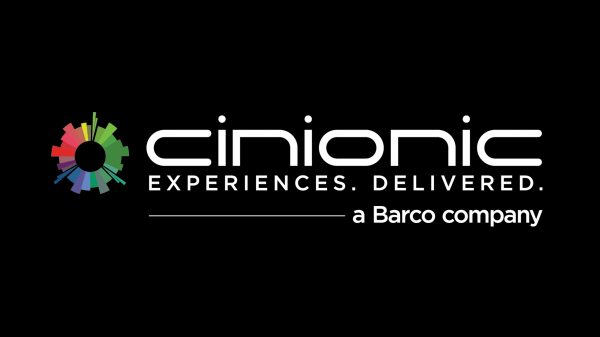On this week’s episode of the Boxoffice Podcast, sponsored by Cinionic, Rebecca Pahle speaks with Dan Huerta, Director of Technical Solutions at Cinionic, about the laser projection leader’s new Cinionic Laser Screen 2.4—which, paired with one of Cinionic’s Barco Series 4 projectors, elevates the laser moviegoing experience.
Cinionic is one of the key players in the laser projection space; you’ve partnered with AMC, Cinemark, Santikos, and other cinemas all over the world to upgrade their systems to laser projection. Which is why I was a bit surprised to see the news of the Cinionic Laser Screen 2.4. How did Cinionic come to make a screen?
Initially it was conceived as a premium large format, or PLF, screen. During a long period of product development, we realized [the screen] has potential with more than just PLF, large-screen venues. It has the potential to elevate the laser moviegoing experience in auditoriums of all shapes and sizes, whether they be 2D or 3D. At Cinionic and Barco, we’re always looking for ways to innovate and add value.
What is it about this screen that works with Barco Series 4 projectors to improve the moviegoing experience?
[Pairing a Barco Series 4 projector with the Cinionic Laser Screen 2.4] maximizes the presentation efficiency by providing a higher-gain screen, which means you can get the light levels that you need using a lower-power projector. It offers the potential to deploy a lower-cost projector without sacrificing quality, reducing energy costs and providing a lifetime extension of the paired Barco Series 4 projector and our new 2.4 gain screen.
[On a technical side, the pairing lets you] run the same DCI luminance levels on your screen, whether it be 2D or 3D, and whether it be small, medium, or large auditorium. [The Laser Screen 2.4] has very similar characteristics to a lower-gain screen but provides flexibility from a presentation technology perspective, as well as from an energy-saving business perspective.
What is gain, and how does it relate to the moviegoing experience?
Think of [gain] as kind of a reflectivity multiplier. You can have a matte white screen, which has a gain of one. Our new proprietary Cinionic Laser Screen has a 2.4 gain, so 2.4 times the light reflectivity [comes] out of the lens and onto the screen. It does gives you a lot more flexibility–from a projector choice [standpoint] as well as being able to play really bright 2D and 3D images.
The great thing about laser projection in general—especially laser projection by Cinionic—is that it gives the owner-operator of a cinema extreme flexibility from a day-to-day, sustainable image quality perspective. You never have degradation of the light source like you do with xenon lamps. You’re always going to get a bright, crisp image. We’ve developed this new screen to pair closely with Cinionic laser projectors—not just for presentation quality, but also for [decreased] cost of ownership. In some cases, you can save up to 70% on your energy costs by moving from xenon lamp to laser projection.
How did you work with exhibitors in the development of this screen?
Our approach to testing basically took into account thousands of auditoriums worldwide, [which] allowed us to learn, identify, and hone in on the right combination of parameters. Together with our development partner Strong MDI we approached the Cinionic Laser Screen 2.4 with the same process that we use to develop and test all of our new innovations. We had multiple prototypes of the screen and went through multiple stages of testing and development, including installations in live cinema settings across multiple continents. We did comparison testing with multiple screen types and different gains. We used industry standard test patterns and trailer content at lab and theater facilities.
We had both technical and very non-technical staff look at the new screen, and they all noticed the difference. If you’re a moviegoer, even if you’re not very technical, when you go to your local movie theater, you want to see the movie the way the creative talent intended it to be shown, whether that be the audio or the visual side of it. We always take that into account when we’re looking at new innovations and new technologies. When this screen idea came to light, we looked at things like audio quality and speech intelligibility, [which led us to choose a] single-perforation screen—we didn’t want to go with multiple types of perforation. I know it seems seems like a minor detail. We went with [microperforation] only, [to improve] the audio transmission as well as the image performance and associated image enhancements. When you’re using less power, it extends the life of the projector, increases efficiency, and overall lowers your cost of operation.
We took all of the business and technical parameters into account when we were designing and developing the screen. A lot of people look at a screen only the from an image parameter perspective, but we wanted to look at it from an overall presentation quality perspective. We’ve had one screen running at a U.S. theater since the beginning of April of this year, and everyone loves it—both 2D and 3D. It’s been a success for us so far, and we look forward to further innovations on this particular screen model. And who knows? You might might see even more in the future—as it relates to innovations on the audiovisual side—coming out of Cinionic. We are a cinema born and bred [company]. We love what we do, and we’re excited to help not just the cinema owner-operators but the entire industry, including production, post-production, the entire ecosystem. We want to be a key companion to all aspects of that.
This interview has been edited for length and clarity. Visit Cinionic.com for more details.



Share this post